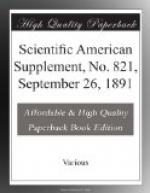as by a paper roof, ten years old and painted two years
ago, which instigated above described experiment.
As long as the roofing paper is fresh and less porous,
especially if the occurring pores are filled and closed
again by repeated coatings, oxidation will take place
far less rapidly. Besides this, the protective
coating applied to the roof surface is exposed most
to this oxidation process. Even by assuming this
constantly progressive destructive action of the oxygen
on the roofing paper to be much less than above stated,
we can readily imagine that it must be quite large.
If it is desired to produce a material free of faults,
it is first of all indispensable that unobjectionable
raw material be procured. Coal tar was formerly
used almost exclusively for the coating of a roof.
It was heated and applied hot upon the surface.
In order to avoid the running off of the thinly fluid
mass, the freshly coated surface was strewn with sand.
The most volatile portion of the tar evaporated soon,
whereby the coating became thicker and finally dried.
The bad properties of the coal tar, pointed out elsewhere,
made it very unsuitable even for this purpose, and
experiments were instituted to compound mixtures, by
adding other ingredients to the tar, that should more
fully comply with its function. It may be said
in general that the coating masses for roofs can be
divided into two classes: either as lacquers or
as cements. To the former may be classed those
of a fairly thinly fluid consistency, and which contain
volatile oils in such quantities that they will dry
quickly. Cements are those of a thickly fluid
consistency, and are rendered thus fluid by heating.
It is not necessary that the coating applied should
harden quickly, as it assumes soon after its application
a firmness sufficient to prevent it from running off
the roof. Coal tar is to be classed among lacquers.
If it has been liberated by distillation from the volatile
oils, it is made better suited for the purpose than
the ordinary kind. The mass contains much more
asphaltum, and after drying, which takes place soon,
it leaves a far thicker layer upon the roof surface,
while the pores, which had formed in the roofing paper
consequent on drying, are better filled up. Nevertheless,
the distilled tar also has retained the property of
drying with time into a hard, vitreous mass, and ultimately
to be destroyed by decomposition.—
The
Roofer.
* * * *
*
A PHYSICAL LABORATORY INDICATOR.
The difficulties attending the management of a physical
laboratory are much greater than those of a chemical
one. The cause of this lies in the fact that
in the latter the apparatus is less complicated and
the pieces less varied. Any contrivance that
will reduce the labor and worry connected with the
running of a laboratory is valuable.
A physical laboratory may be arranged in several ways.
The apparatus may be kept in a store room and such
as is needed may be given to the student each day
and removed after the experiments are performed; or
the apparatus for each experiment or system of experiments
may be kept in a fixed place in the laboratory ready
for assembling; for certain experiments the apparatus
may be kept in a fixed place in the laboratory and
permanently arranged for service.




